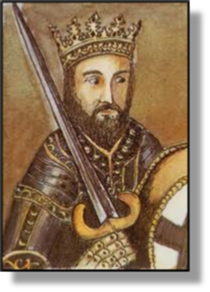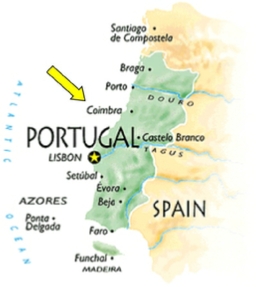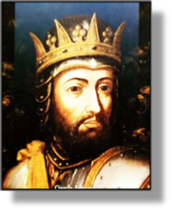


xxxxxIt was Afonso Henriques, Count of Portugal, who, having overthrown his own mother and sent her into exile, set about the founding of Portugal. By 1139 he had won a long war against the Province of León and assumed the title of king. Then, with the aid of some Crusaders who were passing through, he captured Lisbon from the Moors after a siege of four months. By his death in 1185 he had established the new state of Portugal as far south as the River Tagus, and had been duly recognised as its king.
 xxxxxWhen the Almoravids swept into Muslim Spain in 1086, Alfonso VI of León and Castile called upon the support of his son-
xxxxxWhen the Almoravids swept into Muslim Spain in 1086, Alfonso VI of León and Castile called upon the support of his son-
 xxxxxInx1139, after a long campaign which ended in a victory at the Battle of Ourique, he secured the independence of Portugal from the province of León and promptly assumed the title of King. Establishing his capital at Coimbra (arrowed), he then set about the task of extending his kingdom southwards. In 1147 he captured the town of Santarém and then, with the aid of a 12,000 strong army of crusaders which was passing through on its way to Palestine, he laid siege to Lisbon. After seventeen weeks the Muslim inhabitants surrendered to the Christian forces and were allowed to leave the city. In addition to a substantial payment, the Crusaders -
xxxxxInx1139, after a long campaign which ended in a victory at the Battle of Ourique, he secured the independence of Portugal from the province of León and promptly assumed the title of King. Establishing his capital at Coimbra (arrowed), he then set about the task of extending his kingdom southwards. In 1147 he captured the town of Santarém and then, with the aid of a 12,000 strong army of crusaders which was passing through on its way to Palestine, he laid siege to Lisbon. After seventeen weeks the Muslim inhabitants surrendered to the Christian forces and were allowed to leave the city. In addition to a substantial payment, the Crusaders -
xxxxxLater, crossing the Tagus River, Afonso went on to capture the town of Beja in 1162 and Evora in 1165. These towns were later recaptured by the Moors, but by the time of his death in 1185, he had firmly established the independence of the new state of Portugal. Although claiming to be King in 1139, and proclaimed as such in 1143, his title was not officially recognised until 1179 when he placed Portugal under papal protection.
 xxxxxAs we shall see, the task of extending Portugal further south was taken up by Afonso III (1248-
xxxxxAs we shall see, the task of extending Portugal further south was taken up by Afonso III (1248-
xxxxxIncidentally, the name Portugal was very likely derived from Portus Cale, the name the Romans gave to the present-
ST-
PORTUGAL GAINS ITS INDEPENDENCE 1139 (ST)
Including:
Afonso Henriques
and Afonso III

Acknowledgements
Afonso Henriques: illustration from the Portuguese epic poem The Lusiads by Luis Vaz de Camoens (c1524-


